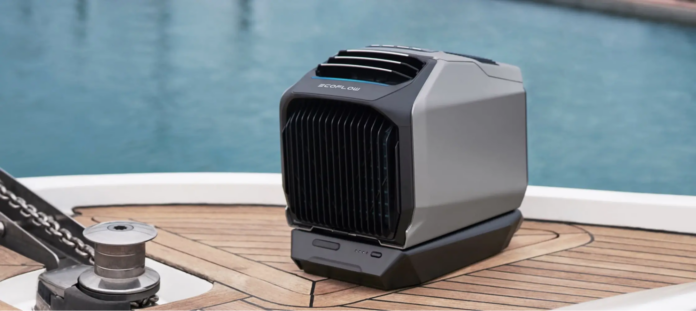Table of Contents
Portable air coolers are great options for those needing cooling in different locations where central air is not an option. They’re ideal for those who like to travel but still want to be comfortable regardless of location.
Today, we’ll look into how they work, the difference between an evaporative cooler and an air conditioner, and the benefits of using these versatile models.
What Is a Portable Air Cooler?
These compact units are designed to be lightweight and versatile, so they can be moved to wherever environment you need to be cooler. Different portable coolers work well in different environments, so it’s essential to understand the differences before you buy one.
Additional AC options include whether it can be used outdoors or only indoors, or if it has a battery or requires it to be plugged in at all times. Built-in heaters are also a great option in both summer and winter, saving you from having to buy multiple appliances. This is particularly important for those living in RVs or tiny homes who might need more space.
The EcoFlow WAVE 2 AC is incredibly versatile; it generates both cold and warm air, can be used on battery power, and can be charged in many ways. It’s also lightweight enough to pack it wherever you need cooling or heating, both indoors and outdoors.
How Do Portable Air Coolers Work?
A portable AC pulls in hot air and runs it over refrigerant-cooled coils in the unit’s compressor, cooling it and extracting moisture simultaneously. They’re great for any environment, but especially for areas with high humidity since they lower the humidity while they work.
While ACs are often known for using a lot of power, EcoFlow’s Solar Panels and portable power stations let you cool your space effectively without contributing to climate change. Furthermore, EcoFlow’s WAVE 2 uses R290, a clean and green refrigerant. It has less global warming potential and won’t damage the ozone layer like traditional refrigerants, so it’s ideal for staying cool and comfortable without worrying about your environmental impact.
What’s the Difference Between an Air Cooler and an Air Conditioner?
While an air conditioner uses a fan to pull in hot air and a compressor to cool it, an evaporative cooler is a device that works a bit differently. Instead of using a compressor to cool the air, it circulates the air over wet cooling pads, causing the water to evaporate, with the water vapor then blowing out using a fan. The evaporation process and the added moisture help extract excess heat from the environment.
However, one major drawback to evaporative coolers is that they only work in dry climates with very low humidity. The lower the humidity, the better they work. They become ineffective at anything above about 50% humidity because they make the room more humid than it already is. While that can be beneficial in arid climates, it makes areas very uncomfortable in humid climates.
Are Portable Air Coolers Effective?
These highly effective compact units work well in several indoor and outdoor environments, allowing you to stay comfortable no matter where you are.
Can a Portable Air Cooler Cool a Room?
Yes, using portable ACs in the home will effectively cool a room. For example, the EcoFlow WAVE 2 has a 4,000 BTU cooling capacity, which cools an average-sized bedroom in under ten minutes. If you live in an arid climate, you can use an AC or evaporative cooler to cool your room, and both work much better than simple fans without any cooling ability.
The Benefits of Portable Air Coolers
There are many benefits to using a portable AC to help regulate the temperature of your environment.
Fast and Effective
Since quality portable ACs can cool a room in under 10 minutes, they’re a fast and effective way to keep yourself cool on a hot day.
Can Be Moved Wherever Needed
Because they’re compact and lightweight, you can move ACs wherever you need them, from room to room, in your RV or tent, or even for outdoor use.
Multiple Ways to Power Them
Not all models have more than one way to power them. However, the EcoFlow WAVE 2 can be powered using batteries charged using a standard household AC plug, DC power from your car, a generator, or solar panels, giving you plenty of versatile options to suit your needs.
No Water to Deal With
EcoFlow WAVE 2 models are waterless, so as long as the humidity is below 70%, the water will evaporate automatically. However, if your environment is more humid than that, you can always install a drainage tube to deal with the excess water.
No Window Needed
Using portable ACs usually doesn’t require access to windows with tubing to exchange airflow. However, in very humid environments, you want the option of installation, like EcoFlow’s WAVE 2, which can be used with or without additional tubing.
No Installation Required
Unlike traditional ACs that require installation, vents, and custom wiring to install, these units are a breeze. Just put it wherever you want to cool your surroundings and plug it in; nothing could be simpler.
Frequently Asked Questions
No, you don’t usually have to put water in your cooler, as long as it’s the air conditioner style. On the other hand, if you have an evaporative cooler, you’ll need to add water daily to ensure it keeps working.
Final Thoughts
Portable coolers are a fantastic, convenient option because you can put them wherever you need them. You can use them in different rooms or move them into your car, tent, RV, or even outdoors, so buying multiple units is unnecessary. They also don’t require complicated installation; just plug them in and watch them work.
Units like EcoFlow’s WAVE 2 Portable AC can be charged in multiple ways and can even be used as winter heaters. If you use solar panels to power it, you can enjoy the luxury and comfort of an AC while reducing your carbon footprint simultaneously.
